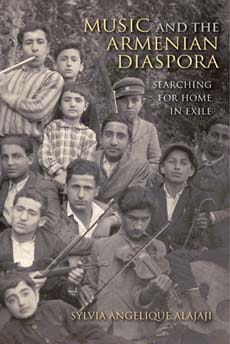
Music and the Armenian Diaspora: Searching for Home in Exile
Kay Campbell
Sylvia Angelique Alajaji
2015, Indiana UP, 978-0-25301-761-1
This engaging book explores the complex ways in which music embodies Armenian identity. Starting with the transcriptions of folksongs by Soghomon Soghomonian, or Komitas (1869-1935), considered the father of Armenian music, the author traces the sounds of Armenian communities in exile in the early 20th century. In the 1920s and ‘30s, New York’s restaurant and nightclub scene featured Armenian musicians performing folk and classical ensemble music of the Ottoman Empire and Turkish Anatolia in a style known as Kef Time. Meanwhile, émigrés in Beirut sang traditional and political songs in large choirs in Armenian. In the 1960s pop-music stars, led by Adiss, created a new style, Estradayin, bringing Armenian music to the wider world. Thousands of Lebanese Armenians moved to California during and after the Lebanese civil war, bringing their music with them. There, these disparate—yet linked—musical styles coexist (although the place of Kef Time in the genre remains controversial), reflecting the many ways Armenians continue to express their identity in music. The book provides links to 10 musical tracks that illustrate the music it discusses.
You may also be interested in...

Book Deconstructs Myth Surrounding Egypt’s Most-Famous Boy King
Egyptologist Aidan Dodson sifts the evidence—from tomb paintings to statuary to temple inscriptions—in his quest to recover the real King Tutankhamun.
Dubai Neighborhood Paves Way for Urban Design Preservation
Architect Peter Jackson and social geographer Anne Coles examine the origins, flowering, decline and restoration of the famed Dubai wind towers.
Ancient Egyptians Still Have Things to Teach Us
Socrates and other Greek thinkers admired Egypt for its philosophical tradition. This new translation of a manuscript as old as the pyramids shows us why.